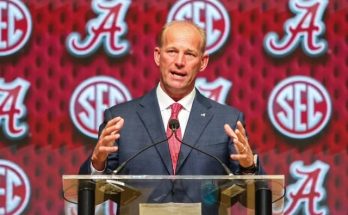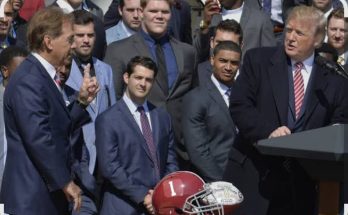Former Maryland football commit Mike Williams has decided to flip his commitment, sending shockwaves through the recruiting world by choosing an SEC powerhouse instead. The four-star defensive back out of Atlanta, Georgia, had been verbally committed to Maryland for months, but in a move that now stands as one of the most discussed flips of the 2025 cycle, he’ll be heading south to compete in the Southeastern Conference.
For Maryland, this is a tough loss. Williams was considered one of the cornerstone pieces of its 2025 class. A long, rangy athlete with elite ball skills and the versatility to play safety or cornerback, he represented more than just talent—he represented momentum. The Terps had hoped to build around him in the secondary and use his commitment as a recruiting pitch to other blue-chip prospects. His decision to reopen his recruitment earlier this spring was the first indication that things may not be going as planned behind the scenes, and it didn’t take long after that for rumors to swirl about his contact with schools in the SEC. Now it’s official: Williams is flipping to the University of Georgia.
Georgia landing Mike Williams is another feather in the cap for Kirby Smart and his staff, who continue to stockpile defensive talent at a rate few programs can match. For the Bulldogs, the addition of Williams gives them yet another elite defender who fits their scheme perfectly. His physicality at the line of scrimmage, willingness to tackle in space, and football IQ make him an ideal fit in the kind of aggressive, disciplined defense Georgia has become known for. This is the kind of player Georgia not only covets but typically develops into an NFL-caliber prospect by the time his college career ends.
The recruiting journey of Mike Williams has been anything but linear. Originally gaining attention as a sophomore at Westlake High School, he quickly established himself as one of the premier defensive backs in the state. Offers began to roll in from across the country—Ohio State, Alabama, Michigan, Oregon, USC. But it was Maryland that jumped out to an early lead. Thanks to the relationships he built with head coach Mike Locksley and defensive backs coach Henry Baker, Williams felt a strong connection to the program. He spoke publicly on multiple occasions about Maryland’s plan to develop him as a hybrid safety/nickel corner, similar to how they had previously used NFL-caliber defensive backs.
But recruiting is rarely about just one thing. In the months that followed his commitment, other programs never stopped pushing. Georgia’s staff made it a priority to stay in touch, even after he gave his verbal to Maryland. LSU and Florida were also lurking, and once Williams reopened things, the race was on.
According to sources close to his recruitment, Williams was drawn to the opportunity to compete against the best every week in the SEC. There was also the allure of playing in front of massive crowds and competing for national championships—something Maryland, despite its rise under Locksley, hasn’t quite been able to offer. NIL discussions reportedly played a role as well, with the SEC schools—particularly Georgia—offering more structured and lucrative packages. But perhaps more than anything, it was the culture at Georgia that ultimately won him over. During his official visit to Athens, Williams spent time with current and former Georgia defensive backs, including several now in the NFL. The message was clear: if you want to be the best, you come here.
Williams’ flip is the latest sign that Georgia continues to dominate the recruiting trail, especially within its home state. Keeping top Georgia talent home has always been a priority for Smart, and Williams joins a long list of elite in-state prospects who have decided to wear red and black. It also sends a message to other recruits that Georgia isn’t resting on its laurels. Even with two national championships in recent seasons and a roster full of blue-chip players, the Bulldogs are as aggressive as ever in building for the future.
For Maryland, there will be some soul-searching to do. The Terrapins have done an admirable job in recent years landing high-profile commitments and developing them into productive players. But holding on to those players through the entire recruiting cycle remains a challenge. The move by Williams is reminiscent of other high-profile flips in recent years that have gone against the Terps late in the cycle. In an era where NIL deals, media visibility, and the promise of playoff contention weigh heavily in decisions, schools like Maryland are left to constantly fight an uphill battle.
The loss of Williams also underscores a broader challenge in college football recruiting: retention. A verbal commitment, especially early in the cycle, means far less now than it did even five years ago. With the transfer portal booming and NIL negotiations becoming more structured and sophisticated, recruits are thinking not just about the next four years, but also about their long-term earning potential and brand development. Schools like Georgia, Alabama, and LSU are increasingly able to pitch not only development and exposure but also stability in an ever-changing landscape. For players like Williams, that pitch is hard to ignore.
As for what comes next, Mike Williams is expected to enroll early at Georgia in January, giving him a head start in acclimating to the speed and physicality of SEC football. He’ll have a chance to compete right away for playing time, especially if some of Georgia’s veterans opt for the NFL Draft after the upcoming season. Coaches believe he could contribute on special teams immediately and possibly carve out a role in nickel packages or sub-defensive alignments by midseason. His football instincts, paired with his athleticism and work ethic, make him a strong candidate to contribute early.
Off the field, Williams will benefit from Georgia’s robust player development program, which includes mental health support, financial literacy training, and branding opportunities through NIL collectives. The school’s infrastructure is designed to help players navigate not just the game of football, but also the business side of being a high-profile student-athlete. That too played a role in his decision, as his family felt more comfortable with the support structure in place at Georgia.
It’s a dream come true for Williams, whose ultimate goal is to make it to the NFL. By choosing Georgia, he’s betting on himself in the most competitive environment possible. The SEC is unforgiving, but it’s also where stars are born. And for a player as talented and driven as Mike Williams, the spotlight is exactly where he wants to be.
In the months ahead, his decision will be dissected by fans, analysts, and coaches alike. Was it the right move? Only time will tell. But for now, Georgia celebrates another major recruiting win, and Maryland regroups as it looks to fill the void left behind. Recruiting is a game of momentum, and while the Terps have lost a key piece, the cycle is far from over. One flip doesn’t define a class—but it can certainly change the trajectory of both programs.
As Williams prepares for his final season of high school football, all eyes will be on him. He’s no longer just a top prospect from Georgia—he’s now a future SEC defensive back with a target on his back and expectations sky high. For the Bulldogs, he’s another weapon in an already stacked arsenal. For Maryland, he’s the one who got away.



